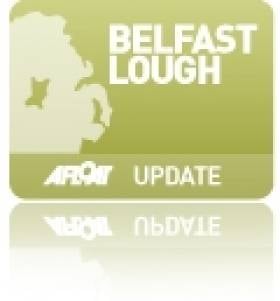Displaying items by tag: Record Tonnage
Record Tonnage Levels for Limerick and Foynes Ports in 2016
#RecordGrowth - Limerick and Foynes both key ports of Shannon Foynes Port Company have reaffirmed the company’s strong performance and contribution to the regional economy in 2016 with growth of 11.4% in year on year tonnages.
For the second successive year, the two largest directly managed SFPC ports have now delivered 10% plus growth, significantly ahead of national and international standards.
Overall tonnages delivered across the company’s activities last year were at just over 11m, marginally behind the company’s record tonnage levels and reflecting the very significant resurgence at the company over the past five years. The tonnage increases were largely driven by strong performing sectors such as construction, oil distribution, agri and renewables.
The growth levels are also in excess of the upper end scenarios envisaged in the company’s Vision 2041 Masterplan published in 2014 and validate, SFPC CEO Patrick Keating states, the ongoing programme of infrastructural investment in quay infrastructure and land capacity.
Furthermore, he states, they reinforce again the growing need for the upgrade of Limerick to Foynes road network, without which the company’s ability to maintain growth and help drive the regional economy.
Reflecting specifically on the 2016 tonnage breakdown, Mr Keating said that while growth at the two premier ports was very positive, tonnages at Limerick really stood out. “The tonnages at Limerick Docks are particularly impressive as our tonnages last year were unprecedented and illustrate again the value and importance of Limerick Docks as a viable port not just for SFPC but for the region. Exports from Limerick docks more than tripled imports in 2016 so that shows just how much an asset it is for business in Limerick and the wider region.
“We have a long term plan for our property in the Limerick Docklands area but this will primarily be centred on maximising the docks as working port and improving connectivity thereto.
Mr Keating added “We have just completed a Limerick Docklands Framework Strategy that maps out the future requirements for the working port at Limerick, as well as plans to reinstate historical buildings such as Bannatyne Mills over time. This Strategy will be launched shortly and we are confident it will have a very positive economic and visual impact on the Dock Road area based on our stakeholder consultations.”
In keeping with its previously announced capital expenditure plans, 2016 also saw the company complete Phase 1 (€12m) of its expansion programme in Foynes.
It also recently acquired a further 90 acres for storage and port development purposes to facilitate growth in Foynes and will lodge a planning application for further multiple phases of its current €50m capital investment programme shortly.
Belfast Harbour ‘Bulked-Up’ by Record Tonnage Growth
#RecordTonnage - Belfast Harbour trade figures reveal that the port handled a record 23 million tonnes during 2014, up 46% since the recession's low point in 2009.
Overall tonnages rose by 1.6%, driven by strong growth in bulk cargo which accounts for over 40% of throughput at the Harbour. Trade sectors which grew particularly well included stone exports (18%), industrial and domestic coal (20%), paper products (33%) and steel (38%).
A record 476,000 freight vehicles also passed through the Harbour during 2014 (up over 2%), while container traffic improved by 2.9% to 125,000 units. The level of new car imports also rose by 10% to 48,000, its highest level since 2007.
Roy Adair, Belfast Harbour's CEO, said: "Surpassing 23 million tonnes for the first time is a major achievement for the Harbour, driven by our ongoing investment programme to deliver best-in-class facilities. It has also been supported by major investments from customers such as Stena Line which has introduced a third ship to its Belfast – Liverpool service.
"Improving economic and consumer confidence across the island has helped drive growth. Increased steel imports, for example, reflects greater manufacturing activity, especially in the Republic of Ireland, while the improvement in freight, containers and new car imports suggests a modest pick-up in consumer confidence.
"As the economy across the island has improved, so too has competition in the port sector. Belfast Harbour is actively pursuing a pipeline of new capital expenditure projects valued at £140m to support further economic growth across the Harbour Estate and to develop new and existing trade opportunities, ensuring that local businesses have access to world class facilities."
The Harbour's animal feed sector performed well, rising 3.3% to a record 2.2m tonnes, while scrap exports rose 14% to a record 373,000 tonnes.
Cement tonnages also improved, increasing fivefold to 79,000 tonnes. This was, however, from a small base and total cement tonnages remain less than one third of pre-recession levels.
Joe O'Neill, Belfast Harbour's Commercial Director said: "Exports from Belfast Harbour grew by 3.6% in 2014, accounting for 42% of all tonnages handled. In 20-years tonnages at Belfast Harbour have grown almost fourfold thanks to a rolling programme of Harbour investment totalling £400 m which has helped develop trade and attracted new business activity in the Harbour Estate.
"A major contributor to that success was Northern Ireland-based quarry firm, Conexpo, which grew its stone exports by 25% to almost one million tonnes in 2014 to meet demand from customers in GB and Europe.
"Conexpo is a good example of a SME whose export growth plans have been supported by Belfast Harbour's investments in new equipment and quays, and the availability of ever larger premises within the Harbour Estate. Our focus over the next 20-years is to ensure that the Harbour continues to grow and invest to support similar success stories."
Ferry passenger numbers remained steady during 2014 at 1.4m while cruise passengers calling at Belfast increased by 23% to a record 112,000.






























































